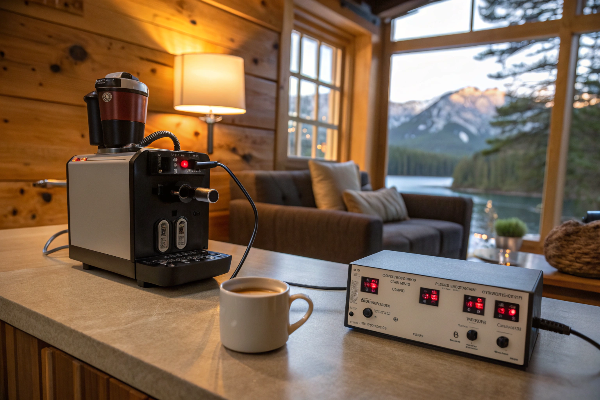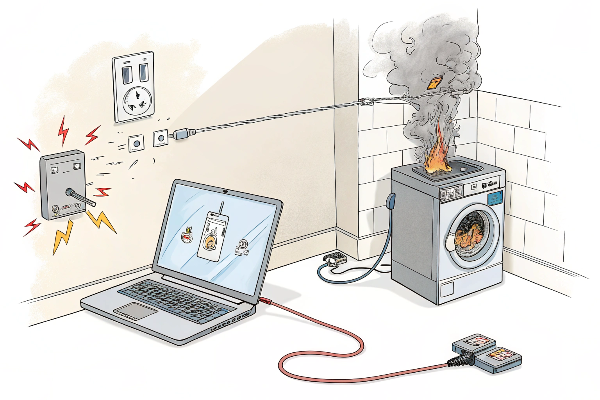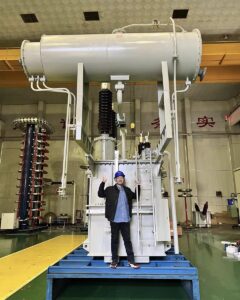Are you struggling with European appliances that won't work in your Canadian home? The voltage difference between countries creates frustrating compatibility issues, potentially damaging your expensive devices or creating dangerous situations.
A voltage transformer works with Canada's 120V/240V supply by converting the electrical current to match your appliance's requirements. For European 240V devices used in Canada, a step-up transformer increases the standard 120V to 240V, while Canadian appliances used in 240V countries need a step-down transformer.
 with Canadian and European plugs](https://voltoritransformer.com/wp-content/uploads/2025/08/1-first-image-voltage-transformer-connecting-eur.png)
Understanding voltage transformation isn't just about numbers—it's about safely managing electrical energy. I've seen too many people buy the cheapest transformer available without realizing that poor quality options can damage equipment or create fire hazards. Let me explain how these devices work and how to choose the right one for your needs.
How to Use European Appliances in Canada?
Have you recently moved to Canada with your European appliances? You might be shocked to discover they won't simply "plug and play" with Canadian electrical outlets, risking damage to your valuable devices.
To use European appliances in Canada, you need a step-up voltage transformer that converts Canada's 120V to Europe's 220-240V. Choose a transformer rated slightly higher than your appliance's power consumption (watts), ensure it has proper certifications (UL/CSA), and use appropriate adapter plugs for physical connection.

European appliances are designed for 220-240V systems, while standard Canadian outlets deliver just 120V. This significant difference means directly plugging in without a transformer will either damage your device or prevent it from working properly. I've helped countless clients navigate this transition, and proper voltage conversion is essential.
When selecting a transformer for European appliances, you need to carefully consider several factors. First, determine the wattage requirements of your device—this information is typically found on a label or in the manual. Always choose a transformer rated at least 20% higher than your appliance's requirements to prevent overheating during operation.
Different appliances have different needs. For sensitive electronics like computers or audio equipment, invest in a pure sine wave transformer rather than cheaper modified sine wave options. Heat-generating appliances like hair dryers or kettles require higher-capacity transformers that can handle surge currents during startup.
I've tested dozens of transformers available in Canada, and there's a significant difference between budget options and properly engineered solutions. Look for models with thermal protection, fuses, and Canadian safety certifications like CSA or cUL. These safety features prevent electrical fires and protect your valuable devices from power surges or overheating.
For temporary use or travel, compact travel transformers might suffice, but for permanent installation, consider a larger, more robust model with better cooling systems. Installing a dedicated 240V circuit through a licensed electrician might be more cost-effective for multiple high-powered European appliances.
How Does a Voltage Transformer Work?
Are you confused by the technical jargon surrounding voltage transformers? Many people plug them in without understanding the science, potentially risking electrical fires or damaged appliances.
A voltage transformer works through electromagnetic induction. It contains two coils of wire (primary and secondary) wrapped around an iron core. When alternating current flows through the primary coil, it generates a magnetic field that induces voltage in the secondary coil, with the voltage ratio determined by the number of wire turns in each coil.
 inside components of a [voltage transformer](https://voltoritransformer.com/what-transformers-are-using-in-power-plant/)](https://voltoritransformer.com/wp-content/uploads/2025/08/3-third-image-internal-components-showing-the-co.png)
The science behind voltage transformation fascinates me—it's a practical application of principles discovered by Michael Faraday nearly 200 years ago, yet still essential for our modern global lifestyle.
Voltage transformers operate on a remarkably elegant principle that hasn't changed much since their invention. When alternating current (AC) flows through a wire, it creates a fluctuating magnetic field. This magnetic field can induce an electrical current in another nearby wire without any direct contact—a phenomenon called electromagnetic induction.
Inside a transformer, the primary coil connects to your power source (like a Canadian 120V outlet), while the secondary coil connects to your appliance. These coils are wound around a shared iron core that efficiently transfers the magnetic field between them. The voltage conversion happens because of the difference in the number of wire turns between the coils.
For example, if the secondary coil has twice as many turns as the primary coil, the output voltage will be twice the input voltage—transforming 120V to 240V for European appliances. Conversely, if the primary coil has twice as many turns as the secondary, the output voltage will be half the input—transforming 240V to 120V for Canadian appliances used overseas.
Modern transformers incorporate various protection features that the pioneers of electrical engineering couldn't have imagined. Thermal fuses prevent overheating, surge protection guards against power spikes, and specialized shielding reduces electromagnetic interference. Higher-quality transformers use better core materials and thicker copper windings to improve efficiency and reduce waste heat.
I've dismantled several transformers to observe these differences firsthand, and the construction quality varies dramatically between budget and premium options. Better transformers maintain more stable output voltage even when demand fluctuates, which is crucial for sensitive electronics.
What Happens if You Plug a 120V Appliance into a 240V Outlet?
Have you ever wondered about the consequences of incorrect voltage connections? This common mistake can lead to catastrophic damage, with smoke, sparks, and permanently ruined electronics.
Plugging a 120V appliance into a 240V outlet without a transformer will likely destroy your device instantly. The excessive voltage forces too much current through the appliance, causing components to overheat and burn out. Some devices may work briefly before failing, while others will be damaged immediately with possible fire risk.

I've witnessed these disasters firsthand and helped clients recover from costly mistakes. Understanding what happens at an electrical level helps explain why proper voltage matching is so critical.
When a 120V appliance encounters 240V power, it experiences double the voltage it was designed to handle. According to Ohm's Law, if resistance remains the same but voltage doubles, the current also doubles. This excessive current generates tremendous heat—often four times more than the device was built to dissipate—leading to catastrophic failure.
Different types of appliances react differently to overvoltage situations. Resistive devices like simple heaters or incandescent lights might briefly glow extremely bright before burning out. More complex electronics with motors, microprocessors, or power supplies typically fail even more dramatically as sensitive components are immediately destroyed.
The specific damage path varies by device. Power supplies are usually the first component to fail, often with a distinctive pop and puff of smoke as capacitors rupture. Internal fuses may blow in an attempt to protect the device, but they're often not fast enough to prevent damage to other components. In motors, excess current can melt the insulation around copper windings, creating internal short circuits.
Safety systems in modern homes provide some protection through circuit breakers or fuses, but these are designed primarily to prevent fires rather than save your appliances. By the time a breaker trips, the damage to your device is usually already done. Some newer appliances have built-in voltage protection that shuts them down if incorrect voltage is detected, but this feature isn't universal.
I've helped troubleshoot countless damaged devices, and the repair costs typically exceed the price of a new appliance. Prevention through proper voltage transformation is always the more economical choice compared to replacement after damage occurs.
Can I Use 240 Volts in Canada?
Are you planning to install 240V equipment in your Canadian home? Many people don't realize that accessing higher voltage isn't just about buying an adapter but requires understanding Canada's unique electrical distribution system.
Yes, you can use 240 volts in Canada as most Canadian homes already have 240V service for large appliances. Standard wall outlets provide 120V, but the electrical panel receives 240V split-phase power. You can access 240V by installing appropriate outlets connected to both phases through a licensed electrician, conforming to Canadian Electrical Code requirements.
 with 120V and 240V circuit breakers [electrical panel](https://www.nyserda.ny.gov/Featured-Stories/All-About-Home-Electrical-Panels) showing 240V circuit breakers](https://voltoritransformer.com/wp-content/uploads/2025/08/5-fifth-image-residential-electrical-panel-with-.png)
One misconception I frequently address is that all Canadian outlets provide the same voltage. In reality, our standard homes have both 120V outlets for everyday items and 240V circuits for heavy appliances like dryers and stoves.
Canadian electrical systems are designed quite differently from European systems, despite both offering 240V capability. In Canada, we use a split-phase system where the utility company provides 240V that's center-tapped to create two 120V lines with opposite phases. When both phases are used together, they provide the full 240V needed for power-hungry appliances.
This dual-voltage system evolved for historical and practical reasons, allowing backwards compatibility with older 120V devices while supporting newer high-power appliances. The implementation follows strict guidelines in the Canadian Electrical Code (CEC), which requires different outlet configurations for different voltages to prevent accidental connections.
For existing homes, adding 240V service for European appliances generally requires a licensed electrician to install a new dedicated circuit from your main panel. The work typically involves running appropriate gauge wiring, installing a double-pole circuit breaker that spans both phases, and mounting the correct receptacle—often a NEMA 6-15 or 6-20 for 240V applications.
New construction offers more flexibility, but still must adhere to code requirements. Some homeowners with multiple European appliances choose to install a subpanel with European-style DIN-rail breakers and outlets, though these must still be fed from the main Canadian electrical panel and meet local inspection requirements.
I've consulted on several projects where properly installed 240V circuits were more cost-effective than using multiple transformers, especially for permanent installations like kitchen appliances, workshop equipment, or home entertainment systems. However, the initial investment in proper electrical work is higher, making transformers more practical for temporary or occasional use.
Conclusion
Properly matching voltages between appliances and power supplies is essential for both safety and functionality in Canada's 120V/240V system. Whether you choose a transformer or dedicated circuits, understanding the electrical principles ensures your devices operate safely and efficiently.
Need expert help with custom transformers for your Canadian renewable energy project? Voltori Energy delivers high-performance, certified solutions tailored to your exact specifications.




